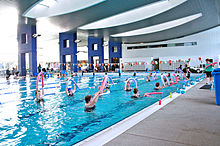Aerobic conditioning
This article has multiple issues. Please help improve it or discuss these issues on the talk page. (Learn how and when to remove these template messages)
|
Aerobic conditioning is the use of continuous, rhythmic movement of large muscle groups to strengthen the heart and lungs (cardiovascular system).[1] Improvement in aerobic conditioning occurs when athletes expose themselves to an increase in oxygen uptake and metabolism, but to keep this level of aerobic conditioning, the athletes must keep or progressively increase their training to increase their aerobic conditioning.
Aerobic conditioning is usually achieved through
Aerobic conditioning makes the
Some neuromuscular diseases recommend regular aerobic exercise (of varying intensities depending on the disease) in order for the skeletal muscles to become aerobically conditioned, providing symptom relief or slowing the course of the disease, for example metabolic myopathies and Duchenne muscular dystrophy.[7][8]
History

Both the term and the specific exercise method were developed by Dr
Benefits
Aerobic Conditioning has many benefits, including:[13]
- build stronger bones
- improve muscle strength, endurance, and flexibility
- Improve balance
- Increase mental function
- Assist in weight management and weight loss
- Reduce risk of developing heart disease, hypertension, stroke or diabetes
- Improve lung function
- Lower blood pressure
- Increase HDL ("good" cholesterol)
- Help to manage blood sugar
Cardiovascular conditioning
Aerobic conditioning trains the heart to be more effective at pumping blood around the body,[5] it does this in a multitude of ways:[14]
- Increasing the stroke volume of the heart (how much blood the heart is pumping per beat)
- Increasing the diameter of the blood vessels, which allows for more blood to move through the body, which in turn allows for more oxygen to diffuse into muscle cells.
- Increasing the size of the heart chambers, enlarging the heart so it can hold and pump more blood.
Maximum oxygen intake (Vo2)
Aerobic conditioning has the ability to raise maximum oxygen intake,[15] meaning that they are able to diffuse more oxygen into their blood than they previously could.
Although exercising at lower intensities improves aerobic conditioning, the most rapid gains are made when exercising close to the
Recommendations
Aerobic conditioning has many benefits to overall health as it can increase physical endurance and lifespan.[18] Once improvement in aerobic conditioning is apparent, for example in metabolism and oxygen uptake, the body progressively adapts to further training.[19]
Aerobic conditioning can be anywhere from walking on the treadmill to mowing the lawn. The average healthy person should engage in 150–200 minutes of moderate aerobic exercise every week. This amount of
Aerobic conditioning increases the amount of physical activity that the body can endure . It benefits sports performance as well.
References
- ^ "AAOS - OrthoInfo". orthoinfo.aaos.org. Retrieved 2016-05-17.
- ^ ("Aerobic Exercise,"2023).
- ^ S2CID 23256471.
- ISBN 1-57954-270-0
- ^ a b "Effects of Exercise on the Heart". Boundless. 2016-01-04. Archived from the original on 2016-10-12.
- S2CID 73481438.
- PMID 37239314.
- PMID 29925809.
- ^ ""Father of Aerobics" Kenneth Cooper, MD, MPH to receive Healthy Cup Award from Harvard School of Public Health". News. 2008-04-16. Retrieved 2018-10-08.
- ^ "Dr. Kenneth Cooper and How He Became Known as the Father of Aerobics". Club Industry. 2008-09-01. Archived from the original on 2018-10-09. Retrieved 2018-10-08.
- ISBN 9781496209504.
- ISBN 9781440851834.
- ^ "Aerobic Exercise". Clevland Clinic. Retrieved 6 March 2024.
- ^ Ph.D., Michael Olpin. "benefits of aerobic conditioning". faculty.weber.edu. Retrieved 2016-10-25.
- .
- ^ Arthur Lydiard's Guide to Athletic Training. A Guide to the Brooks/American Track and Field Lydiard Running Lecture Tour 1999
- ^ Craig, Neil. "Scientific Heart Rate Training." Eureka Quality Printers.1996.
- ^ Mccord, E. (n.d.). Aerobic details.http://www.adapticom1.net/erinmccord/mm/ScieceFair7th/AerobicConditioning-sources.html
- ^ Olpin, D. M. (2011, October 14). Benefits of aerobic conditioning.
- ^ Davidson, J. (2011, September 2). Aerobic Vs. Anaerobic Conditioning. LIVESTRONG.
- ^ Am J Lifestyle Med. (2010). Aerobic Conditioning and Physical Activity.Sage Publications.
Aerobic exercise.(2023, August 15). Cleveland Clinic. Retrieved March 3, 2024.
- Kearns, K. (2011). Aerobic exercise and FASD. University of Victoria, Retrieved from Aerobic Exercise Program and FASD | Fetal Alcohol Spectrum Disorders (FASD)
- Cooper, Kenneth C. The New Aerobics. Eldora, Iowa: Prairie Wind.
- Donatelle, Rebecca J. Health: The Basics. 6th ed. San Francisco: Pearson Education, Inc. 2005.
- Hinkle, J. Scott. School Children and Fitness: Aerobics for Life. Archived 2010-07-19 at the Wayback Machine Ann Arbor, MI: ERIC Clearinghouse on Counseling and Personnel Services.
